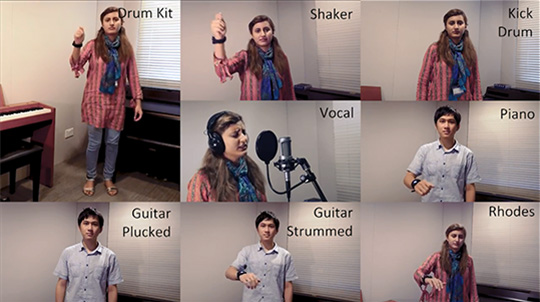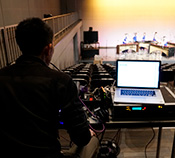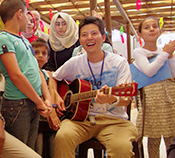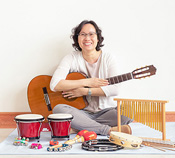Fusing Music and Technology to Shape a World Where Everyone Can Learn.
(Part 2)
Dania Murad / Researcher
Learning × Singing × Technology
Dania Murad is channeling her fascination with the fusion of music and technology into education. We take a closer look at how Dania is using the power of music to lower the hurdles in education and help build a society where everyone can learn on an equal footing.
An application that lets everyone make music of their own.
I am now doing research at the Sound & Music Computing Lab. All of us in the lab embrace the goal of using music to better people’s health and education.
Soon after joining the laboratory in 2017, I led the development of a smartwatch app called “Motion Initiated Music Ensemble with Sensors.” The app transforms a smartwatch into an instrument that plays various musical voices, including the staples such as guitar, piano, saxophone, and drums. People can get together and make music in ensembles by waving their arms.
Motion Initiated is conceived around a “Music for Everyone” concept. The main objective is body movement through music. By moving your arms and legs to play the instruments, you work your body aerobically, which augments the exuberance of the music and improves your health. With wearable virtual instruments, even people untrained in musical performance can enjoy music creation and connect with others in ensembles. The app also eliminates the cost and time involved in obtaining the analog real-life instruments.

Overcoming cultural differences and disparities in educational opportunity by bringing education to everyone through song.
Meanwhile, my current project focuses on education. Specifically, I am using music to promote language acquisition as a way to surmount disparities in wealth and in the education access different countries provide. We recently published “Using Music Technology to Motivate Foreign Language Learning,” a paper on our current understanding of the relationship between music and long-term memory, and the various ways music and technology can contribute to learning mechanisms.
Educational environments are still underdeveloped and inequitable in many countries in the world. My dream is to help improve education in the world. That dream has gravitated my research towards education and shaped my integrated research themes of learning, singing, and computing (technology). In the next few years I hope to elevate my language acquisition project in Singapore to a global level.

Music has surprising hidden potential.
To me, music is both a tool to connect people and a trigger to awaken various memories, experiences, and emotions. Music instantly takes us to past experiences, transcending space and time. You remember happy times, lonely times, fun times, and even sad times. You see who were there, and so on. On a physical level, music helps to relieve stress and fatigue.
Music has abundant potential. Scientists have shown therapeutic benefits of music for conditions such as dementia, Parkinson’s disease, and Alzheimer’s disease. There are even reports that the rates of shoplifting reduced at stores that played fun or relaxing music. There must be surely more potential yet to be discovered. I think there is no limits to the potential of music. This idea motivates me to move beyond my projects in applying music and technology to lower educational hurdles and help shape a world where everyone can learn. One day, I would very much like to see my work have positive impact in the world.

- Dania Murad / Researcher
- Dania Murad graduated from the National University of Sciences and Technology in Pakistan with an undergraduate degree in Computer Engineering in 2014. After 2 years in the telecommunications industry, she joined the graduate program in the Sound & Music Computing Lab in the National University of Singapore. She currently researches the use of music in technology and learning.
Interview Date:



